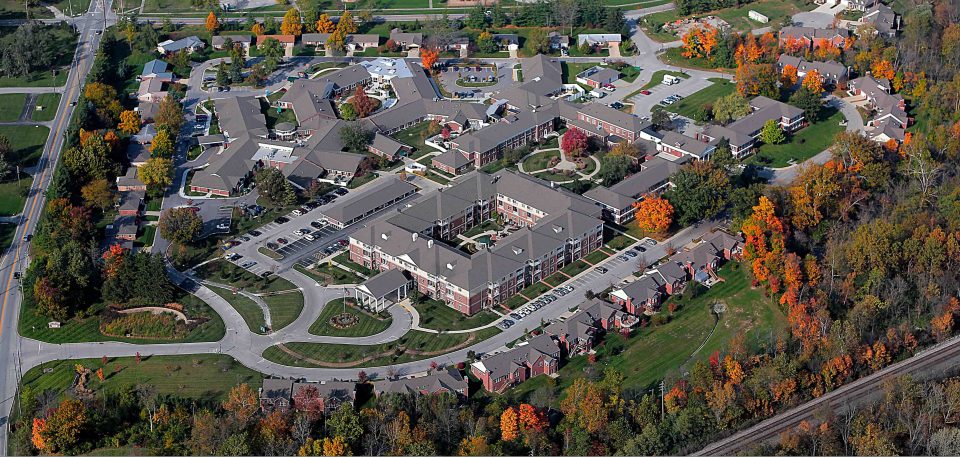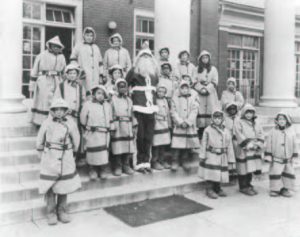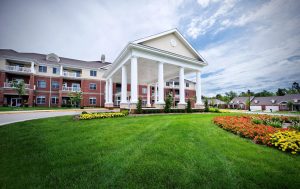The Ongoing Transformation of a Life Plan Community

Westminster Village North, Inc., in Indianapolis, Indiana, is a thriving senior living community that took a hard look at how they could remain viable in a changing marketplace. Partnered with InterDesign, now a K2Mpowered company, Westminster Village North took a bold step towards their future; and this is their story.
Not-for-profit Life Plan communities (the term LeadingAge advocates for continuing care retirement communities) are at a critical crossroads. While the aging of America’s population has created significant opportunities, the marketplace has become significantly more competitive, particularly through the emergence of aggressive for-profit senior care companies, as changes in payment models and insurance reimbursement threaten the financial stability of many communities.
Fortunately, the situation is far from hopeless. In fact, there may never be a better opportunity for not-for-profit communities to secure a solid future and withstand even well-financed competitors. The keys are in understanding the changing needs and expectations of the marketplace, creating a long-term vision, and investing in the future.
Westminster Village North in Indianapolis is a shining example of a not-for-profit Life Plan community that recognized changes and took a strategic approach to ensure its continued viability. Today, the community is prospering, and it continues to remain focused on the future, making it a model for other not-for-profits that wish to do more than simply survive. In this series of articles, we’ll examine the changes in our marketplace and the steps Westminster Village North took to become one of its market’s most desirable and successful communities.
A Place of Isolation Becomes a Destination

Drive around the northeast corner of Indianapolis, and you’ll see all the signs of a healthy, affluent region. Anchored by the luxury-home communities fronting the 1,890-acre Geist Reservoir, and rapidly filling with desirable subdivisions and aggressive retailers, the area has been a development magnet for the past three decades.
A century ago, the area held a different appeal, with empty meadows and few residents. The bucolic setting was the perfect place to isolate victims of the dreaded ‘white plague.” In 1917, local health officials constructed the Sunnyside Sanitarium, a state-of-the-art facility for isolating and treating tuberculosis patients.
Sunnyside’s last patient moved out in 1969. Two years later, Presbyterian Housing Program purchased the abandoned complex and transformed it into a modern retirement housing community under the Westminster Village North name. The main building became a central kitchen, and the smaller structures that formerly housed patient rooms were remodeled into modest apartments, with Plexiglas connectors linking the buildings.
Remaining competitive
Westminster Village North enjoyed a great reputation and healthy occupancy rates for the next quarter-century. It became its own locally managed non-profit corporation, and in 1997, Shelley Rauch, MBA, HFA became Executive Director. She quickly recognized that updating the community was critical. For one thing, changing demographics were fostering new philosophies of senior housing, and Westminster Village North’s design was becoming dated.
An even greater concern was the decades-old infrastructure. “The age of the physical plant was starting to show,” Rauch recalls. “We also knew we weren’t operating as efficiently as we could. We had several buildings, some with as few as 10 apartments, but each had its own mechanical and electrical systems to maintain. Our reputation and quality outcomes were excellent, but we realized that wasn’t going to be enough as people started talking about what the coming generations would expect from senior housing. Clearly, we needed to pursue some capital improvements.”
Debt can be good

Rauch was aware that Westminster Village North’s board took pride in the community’s lack of debt and might be hesitant to make a significant investment, so she initially focused on what the board would view as practical: the infrastructure. “The directors agreed to an engineering study to determine the life expectancy of everything from roofs, to windows, to electrical and mechanical systems. That study told us we had already exceeded the life of everything in all of our buildings.”
A health facility planner who had handled much of the previous renovation work while on Presbyterian Housing Program’s staff, Bruce Spear, had joined InterDesign, an Indianapolis architecture and engineering firm, now a part of K2M Design®, Inc. Rauch reached out to Spear and discussed the situation. He referred her to an investment banking group, which performed an extensive financial analysis concluding that the community’s ratios and cash position would be strengthened with the addition of some debt.
“The board began to recognize that we couldn’t maintain our reputation for long if we didn’t address these challenges,” Rauch notes. InterDesign had handled a well-received renovation to the health center, and in 2000, Rauch asked Spear to create a master plan for the community’s future.
“We talked with different architectural firms about what they could do for us, but the board and I appreciated that InterDesign shared our vision that Westminster felt like a small college campus,” she recalls. “They didn’t want to reinvent us. Instead, they shared our residents’ pride in our grounds and wanted to update the facilities while embracing our history.”
For more information on developing a Life Plan Community, reach out to Director Phil Howard.
About K2M Design & InterDesign
K2M Design®, Inc. continues our strategic growth with the acquisition of The InterDesign Group, located in Indianapolis, Indiana. K2M Design officially acquired InterDesign on May 1, 2017, integrating a talented team of Architects, Interior Designers, Project Managers, and Construction Administrators.
Having completed over 200 projects in the Senior Living and Healthcare markets, the team brings a depth of talent to K2M. Stronger together, we will continue to be leaders in the market, designing for the next generation of seniors.